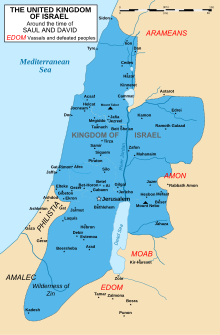Reĝlando Israelo
| Reĝlando Israelo | |||||||||
| |||||||||
| historia lando • reĝlando | |||||||||
|---|---|---|---|---|---|---|---|---|---|
Geografio
| |||||||||
| Ĉefurbo: | Gibeah • Jerusalemo • Hebron
| ||||||||
| Loĝantaro | |||||||||
| Ŝtat-strukturo | |||||||||
| |||||||||
La Unuiĝinta Monarkio (en hebrea הממלכה המאוחדת) aŭ Unuiĝinta Reĝlando estas la nomo havigita por la Izraelida[1] regno de Israelo kaj Judujo,[2][3][4] dum la regadoj de Ŝaul, Davido kaj Salomono, kiel oni priskribis ĝin en la Hebrea Biblio. Tio estis tradicie datita inter 1047 a.K. kaj 930 a.K. Je la sukcedo de la filo de Salomono, nome Rehoboam, ĉirkaŭ 930 a.K., la biblia rakonto reportas, ke la lando disiĝis en du regnoj: nome la Izraela reĝlando (inklude la urbojn de Sikem kaj Samario) norde kaj la Reĝlando de Judujo (enhavanta Jerusalemon) sude.
Por nuntempa fakularo la Unuiĝinta Monarkio estas ĝenerale konsiderita kiel literatura esprimo kaj ne kiel historia realaĵo, indikante al la manko de arkeologia pruvaro. Ĝenerale oni akceptis, ke "la dinastio de Davido" ekzistis, sed multaj kredas, ke Davido povis eble estis nur simple la monarko aŭ tribestro de Judujo, kio estis plej verŝajne tre malgranda, kaj ke la norda regno estis separata apartaĵo. Estas multaj subtenantoj de tiu konsidero.[5][6][7][8]
Referencoj
[redakti | redakti fonton]- ↑ (1966) “Israelite”, The Encyclopedia of the Jewish Religion. Holt, Rinehart and Winston, p. 206–207.
- ↑ (1973) “The United Monarchy: fact or fiction?”, Vox Evangelica 8, p. 33–39.
- ↑ (1996) The True Israel: Uses of the Names Jew, Hebrew, and Israel in Ancient Jewish and Early Christian Literature. Boston: Brill Academic Publishers, Inc.. ISBN 978-0-391-04119-6.
- ↑ de Vaux, O.P., Roland. (1997) Ancient Israel: Its Life and Institutions. Grand Rapids, Michigan: Wm. B. Eerdmans Publishing. ISBN 978-0-8028-4278-7.
- ↑ Lipschits, Oded. (2014) “The history of Israel in the biblical period”, The Jewish Study Bible, 2‑a eldono (angle), Oxford University Press. ISBN 978-0-19-997846-5.
- ↑ Finkelstein, Israel. (2001) The Bible Unearthed: Archaeology's New Vision of Ancient Israel and the Origin of its Stories. New York: Simon & Schuster. ISBN 978-0-684-86912-4.
- ↑ Kuhrt, Amélie. (1995) The Ancient Near East, c. 3000-330 BC, Band 1. Nov-Jorko: Routledge, p. 438. ISBN 978-0-41516-762-8.
- ↑ David, King of Judah (not Israel) (Julio 2014).
Vidu ankaŭ
[redakti | redakti fonton]- steleo de Tel Dan (9-a ĝis 8-a jarcento antaŭ nia erao), kun aramea mencio pri "domo de Davido"
Text is available under the CC BY-SA 4.0 license; additional terms may apply.
Images, videos and audio are available under their respective licenses.


